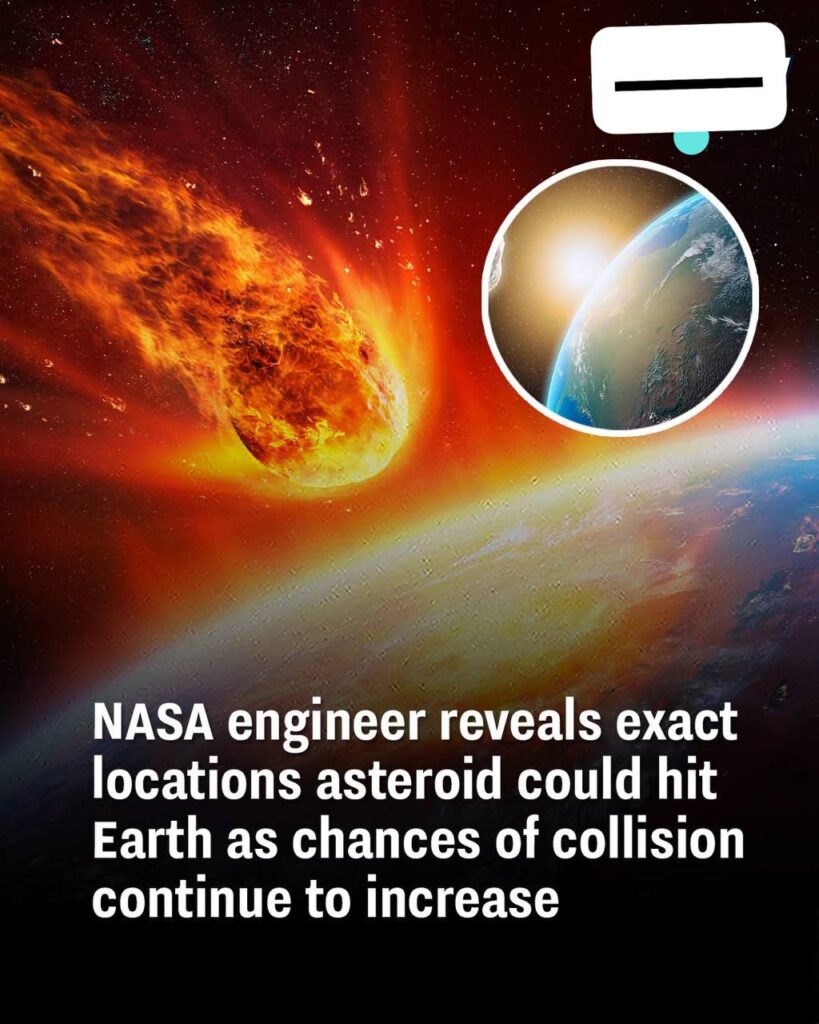In a shocking revelation, a NASA engineer has identified specific locations where an asteroid could potentially impact Earth as the probability of a collision continues to rise. The growing risk has raised global concerns, sparking discussions about planetary defense systems and potential strategies to mitigate catastrophic damage.
As space agencies worldwide monitor near-Earth objects (NEOs), scientists are working diligently to predict impact scenarios with increased precision. If an asteroid were to strike, the consequences could range from localized destruction to global climate effects, depending on the size and location of the impact.
This article delves into the latest warnings from NASA, the potential locations at risk, and what humanity is doing to prepare for such an event.
The Rising Threat of an Asteroid Collision
Asteroids frequently pass by Earth, but most are small and burn up in the atmosphere before causing any damage. However, NASA and other space agencies track thousands of potentially hazardous asteroids (PHAs)—objects that are large enough and close enough to pose a serious threat.
Recent calculations suggest that an asteroid measuring over 100 meters in diameter has a statistically significant chance of colliding with Earth in the coming decades. While the probability remains low, even a 1% chance warrants global attention.
A NASA engineer, part of the Near-Earth Object Program, recently revealed that updated models have narrowed down potential impact locations based on current asteroid trajectories. These calculations take into account the gravitational influences of planets, solar radiation pressure, and variations in asteroid spin that could alter their paths over time.

Exact Locations That Could Be Impacted
The NASA engineer, who remains anonymous due to the sensitivity of the information, provided a list of locations with the highest probability of being affected by a potential asteroid impact. The areas include densely populated cities, oceanic regions, and strategic economic hubs.
1. Atlantic Ocean (Off the U.S. East Coast)
A significant concern is an asteroid impact in the Atlantic Ocean, particularly off the eastern seaboard of the United States. If an asteroid were to hit the ocean, the resulting tsunami could devastate coastal cities such as New York, Washington D.C., Miami, and Boston. A large enough impact could send waves hundreds of feet high, reaching several miles inland.
2. Pacific Ocean (Near Japan and the West Coast of the U.S.)
Another high-risk location is the Pacific Ocean, particularly near Japan and the western coast of North America. A deep-sea impact here could lead to tsunamis affecting cities such as Tokyo, Los Angeles, San Francisco, and Vancouver. The Pacific Ring of Fire, known for its seismic activity, could also experience intensified geological disturbances from such an event.
3. Europe (Major Capitals at Risk)
Calculations suggest that a land impact in Europe could target cities such as London, Paris, Berlin, and Rome. The destruction would be catastrophic, with high casualties and massive infrastructure loss. A mid-sized asteroid strike in Europe would have profound political, economic, and environmental consequences.
4. The Indian Subcontinent (Potential Disaster for India and Pakistan)
South Asia is another region under consideration, with risks posed to major population centers like New Delhi, Mumbai, Karachi, and Dhaka. A significant impact here could wipe out millions and disrupt economic stability in the region.
5. Central and South America (Amazon Rainforest & Coastal Cities)
If an asteroid were to strike South America, the Amazon rainforest could suffer irreparable damage, leading to long-term environmental effects. Alternatively, an impact near coastal cities such as Rio de Janeiro, Buenos Aires, and Lima could result in widespread devastation.
6. Africa (Potential Humanitarian Catastrophe)
An asteroid strike in Africa, particularly in areas with limited infrastructure, would be devastating. Countries with large urban populations, such as Nigeria, South Africa, and Egypt, would experience enormous loss of life and economic collapse.
What Would Happen If an Asteroid Hit Earth?
The consequences of an asteroid impact depend on several factors, including the object’s size, speed, and impact location.
Local and Global Consequences
- Small Impact (10-50 meters in diameter): Could destroy a city-sized area, similar to the Tunguska Event of 1908 in Siberia, which flattened 2,000 square kilometers of forest.
- Medium Impact (50-500 meters in diameter): Could cause regional devastation, massive tsunamis, and environmental consequences lasting decades.
- Large Impact (500 meters to several kilometers in diameter): Could cause global climate change, blocking sunlight with debris and leading to a “nuclear winter” scenario similar to the asteroid that led to the extinction of the dinosaurs 66 million years ago.
NASA’s Planetary Defense Strategies
NASA, in collaboration with other space agencies, has developed multiple strategies to prevent or mitigate asteroid impacts. These include:
1. The DART Mission (Double Asteroid Redirection Test)
NASA successfully launched the DART mission, which tested the ability to change an asteroid’s trajectory by crashing a spacecraft into it. The test, conducted in 2022, demonstrated that kinetic impactors could be a viable planetary defense strategy.
2. Nuclear Deflection Strategies
While controversial, some scientists propose using nuclear explosions near an asteroid to alter its course without destroying it. The energy from such an explosion could push the asteroid into a safer trajectory.
3. Gravity Tractors
A more controlled method involves sending a spacecraft to fly alongside an asteroid, using its gravitational pull to slowly adjust the object’s path.
4. Laser Ablation
Future missions may utilize powerful lasers to vaporize portions of an asteroid’s surface, creating thrust that alters its course.
How Likely Is an Asteroid Collision?
While catastrophic asteroid impacts are rare, the chances are never zero. NASA’s Near-Earth Object Program monitors thousands of asteroids, refining their trajectories with advanced models. Currently, the probability of a significant impact within the next 100 years remains low but is not impossible.
One of the asteroids under close observation is Apophis, a 370-meter-wide asteroid that will pass very close to Earth in 2029. While current models indicate it will not impact the planet, continued tracking is necessary to ensure its path remains clear.
What Can We Do to Prepare?
Although asteroid defense is primarily the responsibility of governments and space agencies, individuals can stay informed and support initiatives focused on planetary protection. Here are some steps:
- Stay Informed – Follow NASA, ESA, and other scientific organizations for updates on near-Earth objects.
- Support Space Research – Funding asteroid detection and deflection missions ensures Earth is prepared for future threats.
- Emergency Preparedness – While unlikely, knowing emergency response plans for tsunamis or impact scenarios can be valuable in high-risk regions.
- Advocate for Global Cooperation – Asteroid threats require global collaboration. Supporting international efforts to track and deflect asteroids ensures humanity’s safety.
Conclusion
NASA’s latest revelations about potential asteroid impact locations highlight the ever-present need for planetary defense. While the probability of an imminent collision remains low, the consequences of an impact would be severe, warranting continued research and preparedness.
Humanity has the knowledge and technology to track and mitigate asteroid threats, but sustained effort is required. As space agencies refine their models and implement deflection strategies, the world must remain vigilant to ensure Earth’s safety from celestial hazards.


